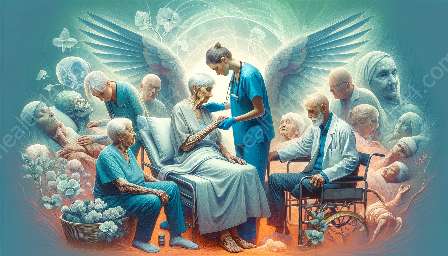Palliative care for geriatric patients involves providing support and comfort to those with life-limiting illnesses, aiming to improve their quality of life. While managing symptoms and addressing psychological and spiritual concerns are central components of geriatric palliative care, the role of physical activity and mobility is equally crucial. This topic cluster explores the intersection of physical activity, mobility, and geriatric palliative care, shedding light on the holistic approach to caring for elderly patients at the end of life.
The Intersection of Geriatric Palliative Medicine and Physical Activity
Geriatric palliative medicine emphasizes the importance of understanding and addressing the unique needs of older adults with serious illness. Physical function and mobility play a significant role in the overall well-being of geriatric patients, even in the context of palliative care. Integrating physical activity into the care plan of terminally ill elderly patients can help manage symptoms, maintain functional independence, and improve their overall quality of life.
Benefits of Physical Activity in Geriatric Palliative Care
Physical activity has various benefits for geriatric palliative care patients, including:
- Pain Management: Regular physical activity, such as gentle stretching or low-impact exercises, can help alleviate pain and discomfort, enhancing the patient's comfort.
- Mood Enhancement: Engaging in physical activity releases endorphins, which can contribute to a more positive mood and reduce feelings of depression and anxiety.
- Improved Mobility: Exercises tailored to the patient's capabilities can help maintain or improve mobility, contributing to their sense of independence and well-being.
- Reduced Risk of Complications: Physical activity, when incorporated appropriately, can help mitigate the risk of complications such as pressure ulcers, muscle atrophy, and joint stiffness.
- Enhanced Social Interaction: Group activities or simple exercises can create opportunities for socialization and connection, addressing the emotional and psychological needs of geriatric palliative care patients.
Challenges and Considerations
While physical activity holds great potential in geriatric palliative care, healthcare providers must consider a variety of factors when implementing such interventions. Some of the challenges and considerations include:
- Individualized Approach: Each patient's physical capabilities and limitations must be carefully assessed to tailor an individualized physical activity plan that considers their unique needs.
- End-of-Life Fatigue: Patients at the end of life may experience severe fatigue, limiting their ability to engage in physical activity. Careful pacing and adjustments are essential to prevent overexertion.
- Adapting to Changing Conditions: As the patient's condition evolves, their ability to participate in physical activities may change. Regular re-evaluation is necessary to adjust the care plan accordingly.
- Functional Decline: Addressing the potential decline in physical function and mobility is crucial, requiring a proactive approach to maintaining comfort and quality of life.
The Role of Mobility in Geriatric Palliative Care
Preserving and promoting mobility is a vital aspect of care for geriatric palliative patients. Enhancing mobility can contribute to the patient's dignity, autonomy, and overall well-being, even in the face of progressive illness. Mobility-related considerations in geriatric palliative care encompass:
- Assistive Devices: Identifying and providing appropriate assistive devices, such as walkers or wheelchairs, can facilitate safe mobility for patients with physical limitations.
- Environmental Modifications: Ensuring that the patient's environment is conducive to safe mobility, with considerations for accessibility and potential fall risks, is crucial to promoting independence and reducing the risk of accidents.
- Education and Support: Educating both patients and caregivers about mobility strategies, safe transfer techniques, and fall prevention measures can empower them to actively participate in maintaining mobility and safety.
Community Engagement and Inclusion
Even in the context of palliative care, efforts to engage geriatric patients in meaningful community activities and experiences can have a positive impact on their emotional and social well-being. Therapeutic outings, visits from community members, and inclusion in social events can enrich the lives of elderly patients and contribute to their sense of connectedness and fulfillment.
Holistic Approaches to Geriatric Palliative Care
Physical activity and mobility are integral components of a holistic approach to geriatric palliative care, complementing the medical, psychological, and social aspects of patient-centered care. By recognizing the importance of physical well-being and independence, healthcare providers and caregivers can support geriatric patients in living as fully as possible, even in the context of life-limiting illness.
Collaborative Care and Interdisciplinary Approach
Educating and involving a multidisciplinary team in geriatric palliative care helps ensure that physical activity and mobility considerations are integrated seamlessly into the overall care plan. From physicians and nurses to physical therapists and social workers, each member of the care team plays a crucial role in promoting the well-being and comfort of geriatric palliative care patients.
Embracing Individual Preferences and Goals
Understanding the unique preferences and goals of each geriatric patient is essential in designing tailored physical activity and mobility plans. Whether a patient enjoys simple walks in the garden or engages in gentle chair exercises, respecting their individual choices and limitations fosters a person-centered approach to care.
Conclusion
Physical activity and mobility are vital components of comprehensive geriatric palliative care. By recognizing the benefits, challenges, and considerations associated with integrating physical activity and promoting mobility in this patient population, healthcare providers and caregivers can foster a more holistic and supportive environment for elderly individuals facing life-limiting illness. Embracing the intersection of geriatric palliative medicine, geriatrics, and physical well-being allows for a more integrated and person-centered approach to caring for the aging population during their end-of-life journey.


